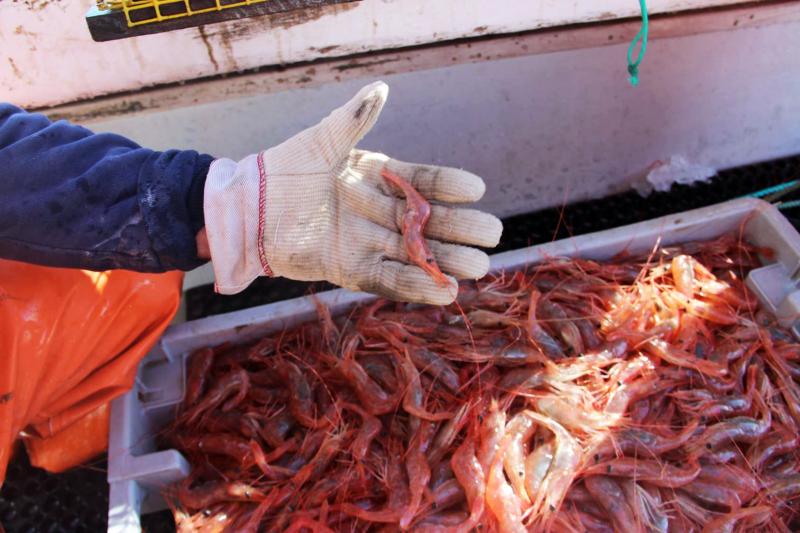Through Jan. 4, operators of local fishing vessels can apply to harvest a limited number of shrimp, and help scientists learn about the Gulf of Maine’s shrimp population.
It has become so depleted that for the third consecutive year, no commercial shrimp fishing is being allowed. However, a project called the Northern Shrimp Cooperative Sampling Program for 2016 will collect samples of the northern shrimp for the purpose of collecting data.
Marine biologists will use the data to determine the timing of the egg hatch, and the size, gender and developmental stage of the shrimp, according to Margaret Hunter of the Maine Department of Marine Resources (DMR).
On Dec. 17, Hunter sent out a letter to Maine harvesters and wholesale dealers stating that the Atlantic States Marine Fisheries Commission (ASMFC) and the states of Maine, New Hampshire and Massachusetts were seeking four shrimp trawling vessels and captains to collect shrimp samples in four regions of the Gulf of Maine, beginning in mid- to late January 2016.
The letter stated that the vessels should fish approximately once every two weeks, until the shrimp were no longer carrying eggs, sometime around the end of March. Each participating trawler would be required to conduct five research trips in one region, and will be compensated $500 per trip. Each would be allowed to sell up to 1,800 pounds of shrimp per trip.
In addition to the trawlers the ASMFC and Maine DMR are seeking two shrimp-trapping vessels to collect samples in the Midcoast Maine area beginning around Feb. 1. The boats would be required to continue hauling until the shrimp have hatched off all their eggs. Each vessel would be allowed to fish up to 40 traps, and haul as often as necessary during the project, with a 600-pound weekly catch limit. The shrimp may be sold, but there will be no other compensation for the trappers.
“Since the ’70s and up through 2013, when we had a shrimp fishery, we had a port sampling project where we'd go down to the docks and interview fishermen and collect samples from the catch,” Hunter said. “We'd use the samples in our annual assessments to give us an idea of what was going on with the shrimp population.
“This year we want to mimic what we were doing then.”
Surveys are also conducted each summer, when the shrimp are offshore. “That's where you'll find a good mix that shows all the different sexes and sizes,” Hunter said.
2013 was the last season there was an abundance of shrimp, though fewer than in previous years. “Things were already declining by then,” Hunter said. “We recommended a reduced catch for that year, and in 2014 and 2015 we recommended none.”
This winter Hunter said biologists will be collecting samples to get more information. “There's a theory that one of the reasons for the decline in shrimp is that temperatures in the Gulf of Maine have been warmer. “If the shrimp are carrying eggs in the fall through the winter, and the temperatures are warmer than usual, the eggs will develop faster than usual, and they will be hatched earlier than usual. We're very interested in the timing of the egg hatch and whether that has changed. There is some evidence that it starts earlier but goes longer. There are still shrimp that hatch at the regular time but now there are some that are starting to hatch earlier.
“We'll be trying to confirm what we saw in the summer. Is that 2014 class going to come inshore? If it does we predict the females will be smaller, because they’re only three years old.”
The trawlers will make five trips, the first one in late January when the shrimp should all be still carrying their eggs. Then they will make a trip about every two weeks after that. After the third trip, if the shrimp are still all carrying eggs, it will show that the hatch is going to be late this year.
All Maine license holders are eligible. There will be one trawler from Massachusetts or New Hampshire, one from Western Maine, one from Eastern Maine and one from the Midcoast. Anybody who has had a shrimping license in those areas and can show that they have had some landings is eligible to apply. There can be no history of violation.
The “winners” will be drawn from a hat.
“Last year the boats did pretty well, and they could have named their price,” Hunter said. “I think people are realizing that, so we may have more applicants this year.”
Trappers will be allowed to put out 40 traps and sell, or keep, up to 600 pounds each week. They can haul their traps as often as they like. Any catch over 600 must be thrown back.
Applications are due by Jan. 4. There were no applicants from the Boothbay Harbor area last year.
According to Hunter the total shrimp catch In 2012 was was 5,479,435 lbs. Total landings in 2013 were 761,708 lbs.
The maximum potential landings for 2016 shrimp will be 48,000 lbs.
Three of the trawlers will be in Maine waters; the other will be in MA and/or NH. Both trappers will be in Maine waters.
An interesting fact about shrimp: They are protandric hermaphrodites – they have characteristics of both sexes, and they start life as males and morph into females. A shrimp will function as a male for around two and a half years, and the winter they turn three they transition into a female. The next summer the shrimp mate as females and produce eggs that fall.






























